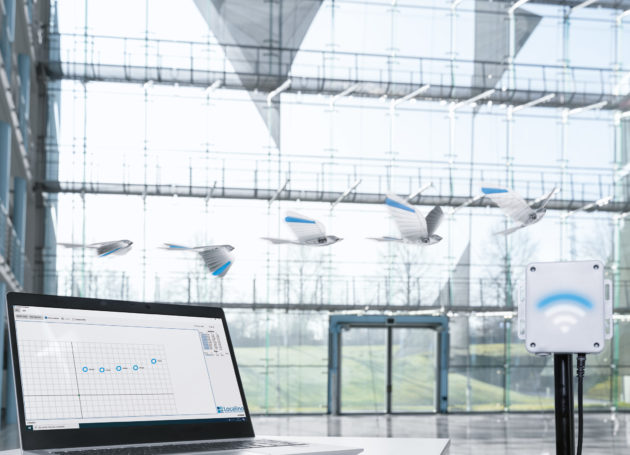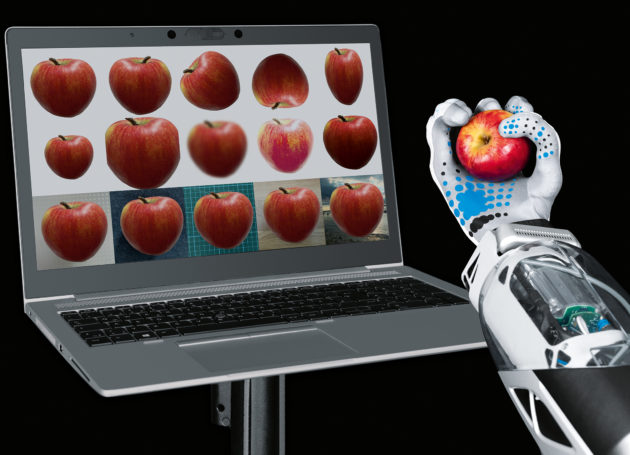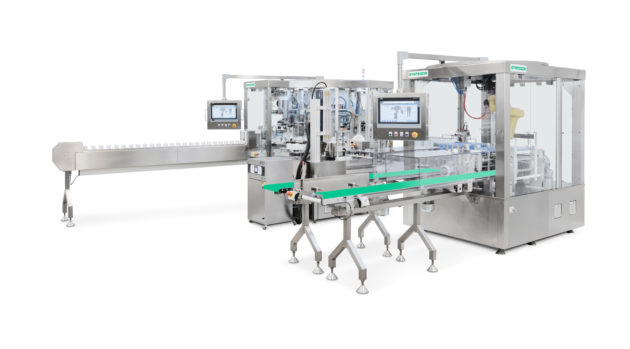I remember the first trip I made to Festo in Germany many years ago. I thought, this is “just” a pneumatics company. What could be interesting about this trip? Then I witnessed what their R&D engineers did with pneumatics. And saw that the company if far deeper than “just” pneumatics.

Even though we could not experience in the flesh, so to speak, this year’s press conference and demonstrations did not disappoint. The company discusses financial results, strategy, general information, an application – assembly of insulin injection pen, workforce issues, and the always delightful demonstration of pneumatic/electronic far-out thinking with this year being a bionic swift (bird).

Most companies I work with have an education and training component. Festo has a division that is dedicated to education from children to adults. Check out the Festo Didactic information below. Maybe you can purchase a bionic bird education kit for your local school’s science and technology program (see information below). I’m living in a new community, but I’m looking for local contacts to help out.
Financial years 2020/2021
Festo’s results were stable despite the pandemic. The Festo Group had to cope with a 7.5% decline in turnover in the 2020 financial year due to the pandemic. Turnover was 2.84 billion euros (previous year 3.07 billion euros). Overall, however, thanks to forward-looking cost-cutting measures and employment protection, the operating result in 2020 was slightly higher than in the previous year.
“This has enabled us to guide our workforce safely through the crisis year and to create a good basis for being ready for the global economy to pick up again. At the same time, it gives us the financial freedom to invest in our future now as well,” said the Chairman of the Management Board, Dipl.-Ing. Dr. h.c. Oliver Jung.
As in the previous year, the company’s R&D ratio was 8% of turnover.
For 2021, the company expects a catch-up year. “We started the year well, with strong growth in the first quarter. Nevertheless, the end of the pandemic cannot yet be estimated. We are therefore continuing our savings course. At the same time, we continue to invest in our growth and innovation strategy,” Jung affirmed.
Strategy 2025+
Digitalisation and AI determine the product roadmap with smart and intelligent products as enablers for energy efficiency and sustainability in customer solutions.
Festo is focusing on the capability shift upgrading employees’ skills in the digital transformation.
The need for home schooling and virtual training (Digital Education) is growing rapidly in the pandemic. In the lockdown, Festo Didactic successfully launched its new digital learning platform, Festo LX, for technical education and provided a free homeschooling version for mechatronics courses in schools.
The LifeTech business segment with medical technology and laboratory automation is experiencing a real boom with growth rates of over 100%. Festo is continuously expanding its Technical Engineering Center for LifeTech in Boston, which opened in 2018 and is one of the world’s most important development locations for life science, in order to further develop this promising growth market.
Festo’s products make an important contribution to the fight against COVID 19. In particular, laboratory automation enables high throughput in COVID 19 tests. Automation is also key in vaccine development and production.
Sustainability needs automation and education
“As a company and society, we have to manage the balancing act in the pandemic of simultaneously finding ways out of the crisis and focusing our future activities on sustainability. Automation and technical education are a key to this. We also have a high social responsibility for sustainable development here,” said Jung. The goal is to gradually develop production in the direction of a circular economy.
“At Festo, we are convinced that pneumatics in particular offers massive advantages over electrics in many areas, and that no other technology can match it. We are currently developing this further in the direction of smart and digital pneumatics. There is still a lot of potential here,” confirmed Jung.
In 2020, Festo has also made great progress internally in climate protection and thus towards its climate target of saving at least 30% CO2 by 2025 (Scope 1 and 2).
Festo has the greatest leverage for climate protection with its customers, through the appropriate product selection of pneumatics and electrics (Scope 3). This is because around 90% of CO2 emissions are generated during product operation and only around 10% during production. Smart products and services, digitalization and AI are giving new impetus to energy efficiency on the way to CO2-neutral production.
As a family-owned company, Festo thinks and acts responsibly and with a long-term perspective. Festo stands for clear values, utmost quality and customer-oriented innovation. It has set standards in industrial automation technology and technical education ever since its establishment, thereby making a contribution to sustainable development of the environment, the economy and society.
Festo is advancing digitalisation in all its corporate divisions. Festo is leading its customers and employees into the digital future. To this end, the company is developing new future-oriented concepts founded on the triad of innovative and energy-efficient technologies, intuitive human-machine collaboration, and education and further training.
Productivity – Festo’s core competency Innovation for the best possible productivity, a global presence and close, long-term partnerships with its customers are the hallmarks of Festo. In the 1950s, Festo became the first company in Europe to use compressed air as a drive medium in automation. The company now offers over 30,000 products and system solutions for pneumatic and electrical automation technology which, thanks to a large variety of modular systems, can be tailored to specific customer applications in many different factory and process automation industry segments.
Added value through digitalisation Smart products, connectivity, the mining and interpretation of data, including via the cloud, and dashboards for visualisation, already offer added value for customers. Products like the energy efficiency module E2M, IO-Link-capable components, the CPX-IOT gateway or interfaces like OPC-UA contribute to this process. Another basic requirement for successful and consistent digitalisation is mechanical, electrical and intelligent connectivity through software solutions, enabling all customers to find their bearings quickly and intuitively.
Festo is promoting this with an open automation architecture and a large product portfolio made up of axes, motors and controllers. Standardised software tools are also being developed: configurators for smart engineering, the Festo Automation Suite for easy commissioning and the digital maintenance manager Smartenance for reliable operation. Digitalised pneumatics such as the Festo Motion Terminal VTEM makes pneumatics more flexible than ever before. The reason: apps define the function, the hardware remains the same.
In addition, data analytics, machine learning and artificial intelligence are shaping the agile product development of the future. Since 2018, the competence in the field of AI has been strongly expanded. The Festo AX (Festo Automation Experience) software platform is an AI-based software solution that allows production processes to be improved, e.g. with preventive maintenance of assets and machines, monitoring of quality in production or energy consumption.
With AI-based solutions for operations and maintenance processes, the overall equipment efficiency (OEE) of customers is to be improved.
Qualification in the digital transformation
As a leading provider of technical education and training, Festo Didactic is responding to current megatrends such as digitalisation and the energy transition. Because these trends are changing industry and production processes. Festo Didactic supports its customers with learning solutions and supports them to ensure the employability and productivity of employees and companies.
Festo Didactic offers a comprehensive range of learning solutions. Learners acquire technology knowledge and soft skills both in team-oriented and practical training on physical learning systems with industrial components, but also location- and time-independent through digital online learning opportunities. The new digital learning portal Festo Learning Experience (Festo LX) creates individual learning experiences for learners and teachers.
The fast way to a safe insulin pen
Syntegon’s assembly system for medical technology with the Festo automation platform

Diabetes is on the rise worldwide with around 10 million people being diagnosed with the disease every year. This pushes up the demand for insulin pens for self-injection. Syntegon’s Danish subsidiary has developed an automated system for assembling these pens using the Festo automation platform.
“I have a dream,” says Michael Andersen, Sales Director of Syntegon Technology Sandved in Denmark. “I have a dream of our machines doing on-the-fly format changes. That would be the culmination of our philosophy of flexibility and agility that we strive for in our company,” adds the automation expert.
Flexibility and agility
“By using the Festo automation platform, which includes the servo press kit, we are already very close to making this dream come true,” says Andersen. In fact, Festo’s servo press kit YJKP – a preconfigured modular system consisting of software, controllers and standard electrical drives – can be easily integrated in the plant and offers a high degree of flexibility thanks to the preinstalled software. This means that the modular press system with servo drive for electric pressing and joining up to 17 kN is ready for immediate use and, compared to similar solutions on the market, is both intuitively to parameterize and cost-effective.
“We have installed more than a 100 servo press kits in the automated assembly lines for insulin pens,” says Ulrik Keldke, Head of Syntegon’s engineering department in Sandved. The precisely adjustable pressing and joining forces ensure consistent quality and low reject rates. “What we particularly like about the Festo servo press kit is that it’s quick and easy to commission, and the machine operators don’t need to be trained to use it,” explains chief engineer Keldke.
Quality and safety
“Automating the assembly line is a prerequisite for meeting the requirements for the end product: the insulin pens must be safe and user-friendly,” says Andersen. The pens must not break when used by the patients, as that would put them at risk. The Servo Press Kit keeps the tension and pressure constant. “The glass of the syringes should never be subjected to irregular pressure as they would break,” Keldke says. The automated systems ensure that the insulin pens are always in order and can deliver the exact amount of insulin.
Depending on the machine type, Syntegon’s assembly lines produce up to 300 pens per minute. The degree of automation is scalable according to requirements and can also be adapted at a later date. The machine concepts are based either on a rotary table for low to medium outputs or on a linear transport system for high outputs. The system can be expanded with automatic feeders and stations to increase output and the degree of automation.
Consistency and reliability
Syntegon Technology, formerly Bosch Packaging Technology, sees itself as a provider of integrated solutions. The assembly line for insulin pens can be expanded into a complete line with other systems from the company. Pharmaceutical manufacturers can thus be provided with machines for all process steps, from filling, capping, assembly, testing, to labelling and packaging – preconfigured and from a single source.
The machine control system is based on electrical and pneumatic components and modules from the Festo automation platform. This ensures a consistency of supply since Festo products are available worldwide and offer open interfaces to higher-level controllers. The CPX-E-CEC module from Festo establishes the connection to the process control level, allowing it to be used with Profinet or, for other customers in Europe, with EtherCat. Especially for North American customers, however, the system could also be supplied with an Ethernet/IP module.
Bionic Swift: A Bionically Inspired Robotic Bird
So, the cool demonstration this year was the Bionic Swift. This year’s engineering innovation has been incorporated into the “Bionics4Education” program. Its target market is high school education and also industrial training.
It is one of the oldest dreams of mankind: flying like a bird. The lift and propulsion of birds have been ingeniously achieved by nature. Birds measure, control and regulate their movements continuously and completely autonomously. The inspiration for the development of the Bionic Swift educational kit came from the Bionic Learning Network, a research association with universities, institutes and development companies whose goal is to produce novel technology carriers through the application of bionics. In 2020, the BionicSwift was presented to the public for the first time. Festo Didactic wants to bring the world of bionics together with the education sector in order to promote working in interdisciplinary project teams as well as problem-oriented learning and creativity at schools.
The Bionic Swift is a robotic bird inspired by the bird world. Festo based its development on the natural model of the swallow. With the experimental set, scientific and technical correlations as well as the fascination of bird flight and the topics of lightweight construction, energy efficiency and aerodynamics can be impressively conveyed in STEAM lessons using a project-based approach.
The mechanisms of action of the flap of the wings can be explored in a playful way by students in class. Weighing less than 45 grams, the ultra-light flying object Bionic Swift shows particularly agile flight behaviour. Due to its extreme manoeuvrability, even tight turns can be realised. The Bionic Swift experimental set is recommended for up to three learners and from the age of 15.
The references to biology and technology that can be taught in STEAM lessons or at extracurricular learning venues are numerous and reach from the structure of tubular bones to wing take-off and landing to the basics of movements in the air. This allows teachers to teach technical learning content via a new, cross-curricular educational learning path. Accompanying teaching material, as well as the assembly manual, can be downloaded free of charge from our website.





